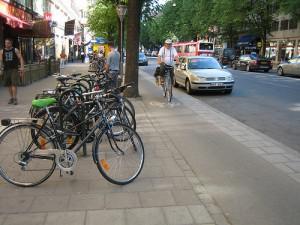 Streets are gathering spaces, public places, places for commerce, and for transportation. They are the veins that pulse through a community. In municipal budgets, they are often one of the top areas to receive investment. For all these reasons, streets are the embodiment of a community’s social and fiscal values. How can streets better reflect a community’s values?
Streets are gathering spaces, public places, places for commerce, and for transportation. They are the veins that pulse through a community. In municipal budgets, they are often one of the top areas to receive investment. For all these reasons, streets are the embodiment of a community’s social and fiscal values. How can streets better reflect a community’s values?
In any conversation about placemaking and urban planning, it is important to begin with a community’s vision. For example, Arlington’s Master Transportation Plan states that “Arlington’s vision of transportation is a system that provides equity and access to all users. It involves concentrating investment in ways that yield the greatest good not only from a transportation standpoint, but also for overall quality of life of Arlington residents and workers” (emphasis mine). This vision sets the framework for not only street design decisions and transportation investments, but also land use decisions.
To implement this kind of vision, many communities are adopting Complete Streets policies that ensure transportation networks are designed and operated in a way that serves all users – walkers, bikers, the elderly, public transit vehicles and riders, automobile drivers, the handicapped. In July of this year, the Michigan Department of of Transportation (MDOT) adopted a statewide Complete Streets policy. The vision foresees “a transportation network that is accessible, interconnected and multimodal and that safely and efficiently moves goods and people of all ages and abilities throughout the State of Michigan. A process that empowers partnerships to routinely plan, fund, design, construct, maintain and operate complete streets that respect context and community values. Outcomes that will improve economic prosperity, equity, accessibility, safety and environmental quality” (emphasis mine). If effectively implemented, this bold vision could reorient the way Michigan’s communities think about their economies, environments, and their quality of life. (See other sustainability efforts taking place in Ann Arbor, MI).
One example of a community attempting to implement a complete streets vision and putting their values in action is in Washtenaw County, MI. MDOT is contemplating converting the four traffic lanes of Jackson Avenue to three, with a dedicated center turn lane, bike lanes, and additional pedestrian crossings. The Washtenaw Bicycling and Walking Coalition (WBWC) found that this conversion would benefit all users by improving automobile traffic flow, reducing the frequency and severity of car accidents through traffic calming, easing travel for larger vehicles with wider lanes, and increasing pedestrian safety by decreasing travel speeds. Guided by a larger vision, these types of incremental changes to the built environment are what bring a community’s values to life.
Image Source

